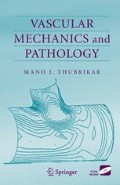Access this chapter
Tax calculation will be finalised at checkout
Purchases are for personal use only
Preview
Unable to display preview. Download preview PDF.
References
Wernig F and Xu Q. Mechanical stress-induced apoptosis in the cardiovascular system. Progress in Biophysics & Molecular Biology 2002;78:105–137.
Humphrey JD. Cardiovascular Solid Mechanics: Cells, Tissues and Organs. Springer Verlag, New York, 2002.
Fung YC. Biodynamics: Circulation. Springer Verlag, New York, 1984.
Dobrin PB. Vascular mechanics. In: Handbook of Physiology. Section 2, Vol. 3: The Cardiovascular System. Shepherd JT, Abboud FM, eds. American Physiological Society, Washington, DC: 1983:65–102.
Silver FH, Christiansen DL and Buntin CM. Mechanical properties of the aorta: a review. Critical reviews in Biomedical Engineering 1989;17(4):323–358.
McDonald DA. Blood Flow in Arteries, 2nd ed. Williams & Wilkins, Baltimore, 1974.
Moore KL and Dalley AF. Clinically Oriented Anatomy, 4th ed. Lippincott Williams & Wilkins, Philadelphia, 1999.
Frohlich ED. Rypin’s Basic Sciences Review, 16th ed. J.B. Lippincott Company, Philadelphia, 1993.
Cheitlin MD, Sokolov M and McIlroy MB. Clinical Cardiology, 6th ed. Appleton & Lange, Norwalk, CT, 1993.
Burton AC. Physiology and Biophysics of the Circulation, 2nd ed. Yearbook Medical Publishers, Chicago, 1965.
Beller CJ, Labrosse MR, Thubrikar MJ and Robicsek F. The role of aortic root motion in the pathogenesis of aortic dissection. Circulation 2004;109(6):763–769.
Valenta J.Clinical Aspects of Biomedicine, 2: Biomechanics. Elsevier, Amsterdam, 1993:143–175.
Vossoughi J, Hedjazi Z and Borris FS. Intimal residual stress and strain in large arteries. In: 1993 ASME Advances in Bioengineering. American Society of Mechanical Engineers, New York, 1993:434–437.
Patel DJ, Defreitas F, Greenfield JC and Fry DL. Relationship of radius to pressure along the aorta in living dogs. Journal of Applied Physiology 1963;18:1111–1117.
Learoyd BM and Taylor MG. Alteration with age in the viscoelastic properties of human arterial walls. Circulation Research 1966;18:278–292.
Lanne T, Sonesson B, Bergqvist D, etal. Diameter and compliance in the male human abdominal aorta: influence of age and aortic aneurysm. European Journal of Surgery 1992;6:178–184.
Schlatmann TJM and Becker AE. Histologic changes in the normal aging aorta: implications for dissecting aortic aneurysm, The American Journal of Cardiology 1977; 39(1):13–20.
Okamoto RJ, Wagenseil JE, DeLong WR, etal. Mechanical properties of dilated human ascending aorta. Annals of Biomedical Engineering 2002;30:624–635.
Draney MT, Herfkens RJ, Hughes TJR, etal. Quantification of vessel wall cyclic strain using cine phase contrast magnetic resonance imaging. Annals of Biomedical Engineering 2002;30:1033–1045.
Raghavan ML, Webster MW and Vorp DA. Ex vivo biomechanical behavior of abdominal aortic aneurysm: assessment using a new mathematical model. Annals of Biomedical Engineering 1996;24:573–582.
Holzapfel GA, Gasser TC and Ogden RW. A new constitutive framework for arterial wall mechanics and a comparative study of material models. Journal of Elasticity 2000;61:1–48.
Matsumoto T and Sato M. Analysis of stress and strain distribution in the artery wall consisted of layers with different elastic modulus and opening angle. JSME International Journal, Series C 2002;45(4):906–912.
Von Maltzahn WW, Warriyar RG and Keitzer WF. Experimental measurements of elastic properties of media and adventitia of bovine carotid arteries. Journal of Biomechanics 1984;17:839–847.
Patel DJ and Fry DL. The elastic symmetry of arterial segments in dogs. Circulation Research 1969;24:1–8.
Humphrey JD, Kang T, Sakarda P and Anjanappa M. Computer-aided vascular experimentation: a new electromechanical test system. Annals of Biomedical Engineering 1993;21:33–43.
Deng SX, Tomioka J, Debes JC and Fung YC. New experiments on shear modulus of elasticity of arteries. American Journal of Physiology 1994;266:H1–H10.
Schulze-Bauer CAJ, Moerth C and Holzapfel GA. Passive biaxial mechanical response of aged human iliac arteries. Journal of Biomechanical Engineering 2003; 125:395–406.
Takamizawa K and Hayashi K. Strain energy density function and uniform strain hypothesis for arterial mechanics. Journal of Biomechanics. 1987;20(1):7–17.
Tickner EG and Sacks AH. A theory for the static elastic behavior of blood vessels. Biorheology 1967;4:151–168.
Vaishnav RN, Young JT, Janicki JS and Patel DJ. Nonlinear anisotropic elastic properties of the canine aorta. Biophysics Journal 1972;12:1008–1027.
Fung YC, Fronek K and Patitucci P. Pseudoelasticity of arteries and the choice of its mathematical expression. American Journal of Physiology 1979;237:H620–H631.
Guccione JM, McCulloch AD and Waldman LK. Passive material properties of intact ventricular myocardium determined form a cylindrical model. Journal of Biomechanical Engineering 1991;113:42–55.
Delfino A, Stergiopulos N, Moore JE and Meister J-J. Residual strain effects on the stress field in a thick wall finite element model of the human carotid bifurcation. Journal of Biomechanics 1997;30(8):777–786.
Prendergast PJ, Lally C, Daly S, etal. Analysis of prolapse in cardiovascular stents: a constitutive equation for vascular tissue and finite element modeling. Journal of Biomechanical Engineering 2003;125:692–699.
K.J. Bathe. Finite Element Procedures. Prentice Hall, Englewood Cliffs, NJ, 1996.
Bonet J and Wood RD. Nonlinear Continuum Mechanics for Finite Element Analysis. Cambridge University Press, New York, 1997.
Roveri N, Ripamonti A, Pulga C, etal. Mechanical behavior of aortic tissue as a function of collagen orientation. Makromol Chem 1980;181:1999–2007.
Rights and permissions
Copyright information
© 2007 Springer Science+Business Media, LLC
About this chapter
Cite this chapter
(2007). Structure and Mechanics of the Artery. In: Vascular Mechanics and Pathology. Springer, Boston, MA. https://doi.org/10.1007/978-0-387-68234-1_3
Download citation
DOI: https://doi.org/10.1007/978-0-387-68234-1_3
Publisher Name: Springer, Boston, MA
Print ISBN: 978-0-387-33816-3
Online ISBN: 978-0-387-68234-1
eBook Packages: EngineeringEngineering (R0)

